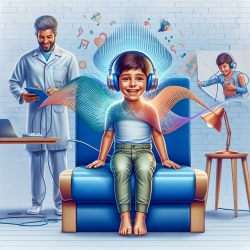Drooling, a common issue among children with cerebral palsy (CP), can significantly impact their quality of life and social interactions. Traditional treatments include pharmacological, surgical, and speech-related interventions. However, a recent study titled "Can muscle vibration be the future in the treatment of cerebral palsy-related drooling? A feasibility study" explores an innovative approach using repeated muscle vibration (rMV) to address this issue. This blog will delve into the findings of this study and discuss how practitioners can implement these outcomes to improve their skills and treatment efficacy.
Understanding the Study
The study conducted at the "Gli Angeli di Padre Pio" Foundation, Rehabilitation Centers in Foggia, Italy, involved twenty-two CP patients aged 5-15 years. The researchers applied an rMV stimulus under the chin symphysis with a 30-minute protocol for three consecutive days. The degree and impact of drooling were assessed using various scales, including the Drooling Impact Scale (DIS), Drooling Frequency and Severity Scale (DFSS), Visual Analogue Scale (VAS), and Drooling Quotient (DQ).
Key Findings
The study demonstrated significant improvements in all measured outcomes, including DIS, DFSS, VAS, and DQ, with notable differences between baseline and post-treatment assessments. The results indicate that rMV might be a safe and effective tool for reducing drooling in CP patients by improving swallowing mechanisms and oral motor control.
Implementing rMV in Practice
Practitioners can consider integrating rMV into their treatment plans for CP patients with drooling issues. Here are some steps to implement this approach:
- Assessment: Use standardized scales like DIS, DFSS, VAS, and DQ to evaluate the severity and impact of drooling before starting rMV treatment.
- rMV Protocol: Apply a low amplitude rMV at a fixed frequency of 100 Hz under the chin symphysis for 30 minutes over three consecutive days.
- Monitoring: Continuously monitor the patient's response to the treatment using the same scales at baseline, 10 days, 1 month, and 3 months post-treatment.
- Adjustment: Adjust the treatment protocol based on the patient's progress and any observed side effects.
Encouraging Further Research
While the study's findings are promising, it is essential to conduct further research to validate these results and explore the long-term effects of rMV on drooling in CP patients. Practitioners are encouraged to participate in or initiate larger sample randomized trials and long-term follow-up studies to gather more comprehensive data.
Conclusion
The use of rMV presents a novel and effective approach to managing drooling in children with CP. By improving oral motor control and swallowing mechanisms, rMV can enhance the quality of life for these children and their caregivers. Practitioners should consider incorporating this technique into their treatment plans and contribute to further research to solidify its efficacy.
To read the original research paper, please follow this link: Can muscle vibration be the future in the treatment of cerebral palsy-related drooling? A feasibility study.










